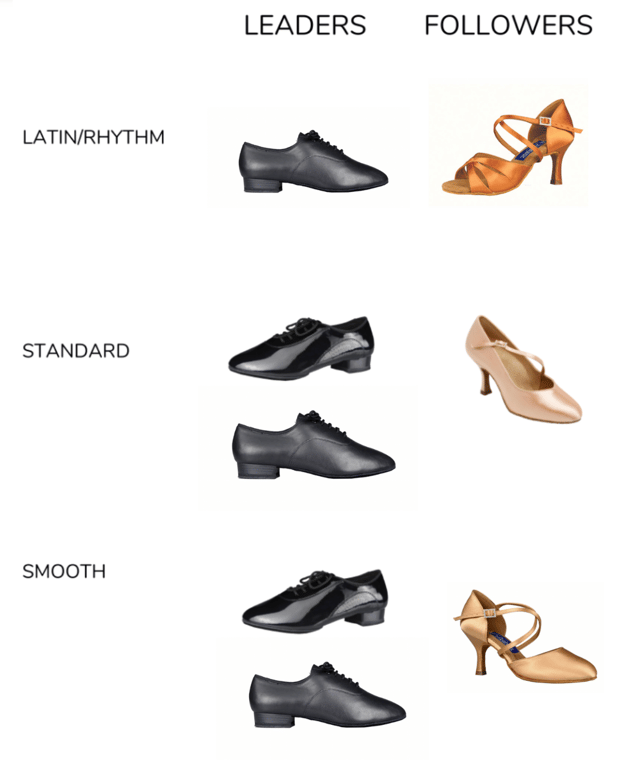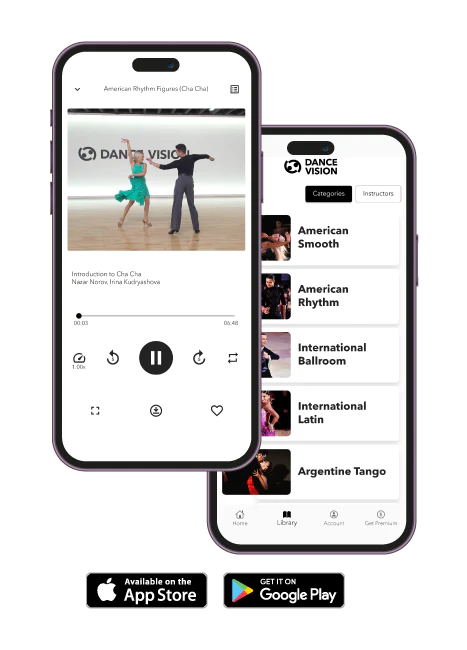Whether you're a beginner or an experienced dancer seeking new footwear, the right ballroom dancing shoes are crucial for enhancing performance, providing support, flexibility, and style. Understanding the intricacies of these specialized shoes is key to improving your dance journey. Join us as we delve into the world of ballroom dancing shoes and help you find the perfect pair to step into rhythm with confidence.
Types of Ballroom Dance Shoes
Leader's Latin/Rhythm dance shoes ensure stability through single or double straps. A common feature is the Cuban heel, offering elevation for spins and turns. The sole, crafted from suede or leather, provides the necessary grip for the dance floor. Regarding Smooth/Standard dance styles, the shoes have shorter heels compared to Latin/Rhythm, focusing on making movements easier, especially during smooth glides. The soles are made of suede material to achieve a balance between grip and slide.
Follower's Latin/Rhythm dance shoes commonly have an open-toe design to enhance flexibility. These shoes may incorporate multiple straps, like crisscross or T-bar styles, ensuring a secure fit that supports the feet during dynamic movements. The slim and high heels not only enhance the elegance of dance movements but also contribute to the overall visual charm of the footwear. For Smooth/Standard dance shoes, it usually come with a closed-toe design, giving extra support and a classic appearance. The only distinction is that Smooth shoes have open sides. Both Smooth and Standard dancing shoes have closed heels, which are shorter than those on Latin/Rhythm shoes.
Heel Heights and Shape
For followers, there is a range of choices available in both heel height and shape. Your instructor may recommend a specific heel height tailored to your skill level. The two most prevalent heel styles are flare and stiletto. Stiletto heels, although less stable, are often favored by experienced dancers for their aesthetic appeal, as they elongate the line of the leg and foot. On the contrary, flare heels serve as an excellent option for beginners or individuals seeking enhanced stability in their footwear.
As for leaders, the heel height remains consistent in both ballroom and smooth shoes. A standard half-inch heel is preferred, as it facilitates proper movement and technique. However, Latin/Rhythm shoes frequently feature a 1.5-inch heel, catering to the demands of these particular dance styles.

Materials and Construction
Ballroom dance shoes, crafted for Leaders and Followers, prioritize comfort, durability, and performance. Leader's shoes typically feature quality leather or synthetic materials, while Follower's shoes may include satin or other elegant fabrics. The soft lining enhances comfort and moisture absorption, while the cushioned insole provides shock absorption. The suede outsole ensures crucial grip on the dance floor. Consistent with the upper material, the heels contribute to the aesthetic, and straps vary, ranging from traditional laces for Leaders to T-bar or ankle straps for Followers. The construction involves lasting for an optimal fit, reinforced stitching for durability, and flexibility for natural foot movement. These lightweight shoes, with secure heel attachment, ensure stability during spins and turns. The meticulous material selection and thoughtful construction are key to meeting the unique needs of both leaders and followers in ballroom dance.
Choosing the Right Size
Selecting the perfect fit for ballroom dancing shoes can be a bit challenging at times. Here are some tips to help you find the right fit for you:
- Correct Sizing - Make sure the shoes snugly fit your feet without being too tight or loose. Ballroom dance shoes may have different sizing than regular street shoes, so check the brand's sizing chart.
- Toe Space - Ensure there's enough room for your toes to move comfortably without feeling cramped or squeezed.
- Secure Heel Fit - The shoe's heel should snugly hold in place for stability during movements. Avoid shoes with excessive heel movement.
- Arch Support - Check that the shoe's arch support aligns with your foot's natural arch for comfort and proper support during dance routines.
- Width - Ballroom dance shoes offer various widths to suit different foot shapes. Choose a width that comfortably matches your foot.
- Strap Adjustability - If your shoes have straps, make sure they're adjustable for a customized fit, snug but not too tight, offering necessary support.
- Test Both Shoes - When trying shoes, wear both simultaneously for an accurate feel of the fit and comfort.
-
Consider Dance Style - Different dance styles may require specific shoes; for instance, Latin/Rhythm shoes may differ in design from Smooth/Standard shoes. Factor in your dance style's specific needs when selecting a pair.
- Comfort Test - Walk around and perform dance movements to evaluate overall comfort. The shoes should feel supportive and comfortable during various motions.
Variations in brands and shoe types naturally result in unique fits for each individual. Dance shoes are crafted to provide a snug fit, with many brands offering a range of widths, lengths, and even customizable options to ensure optimal support for your feet.
Maintaining Ballroom Dance Shoes
Ensure the longevity of your ballroom dance shoes by keeping them clean. Use a soft cloth to wipe off dirt. For suede soles, employ a brush to maintain texture. Rotate between multiple pairs to avoid consistent wear. Store them in a cool and dry place away from direct sunlight and damp areas. Use a shoe bag to protect them from scratches. Avoid dancing on wet surfaces, but if unavoidable, let them air dry naturally. Regularly check and replace heel tips to extend the shoe's life. Consider resoling when necessary, especially for leather-soled shoes. Opt for ballroom dance floors to prevent excessive wear from uneven surfaces. Trim your toenails to prevent damage and use a shoe horn to avoid unnecessary strain on the heel and back of the shoe during wear.
Breaking in Dance Shoes
Break in your dance shoes by wearing them around the house for short periods. Perform flexibility exercises like flexing and pointing your feet, rolling through the soles, and doing small dance movements. Enhance comfort with gel inserts and adapt the shoes to your feet by warming them with a hairdryer and wearing them with thick socks. Use blister-prevention products to avoid discomfort. Gradually increase wear time and dance on smooth surfaces. For persistent discomfort, consult a professional shoemaker or dancer for fitting insights and adjustments.
Here are some other helpful tips from dancers in our community:
- Use a blister/heel guard on the parts of your feet that are more likely to get blisters.
- If you do not want a rigid shoe, you can break the shank of the dance shoe in order to start the process of the shoe molding to your foot.
Should Dance Shoes be "Comfortable"?
You may have reached this point and wondered, "Heels? How long do I have to wear them?" No worries! Dance shoes are designed to provide support for an extended duration. Unlike everyday heeled shoes, dance shoes offer various options beyond just size to ensure comfort, flexibility, and mobility. Many brands offer shoes with different toe box and heel cup sizes, styles, widths, and straps, all aimed at ensuring your comfort in dance shoes.
Wearing dance shoes for an extended period might still result in some soreness, likely from your hard work on the dance floor! In such cases, you can switch to practice shoes or take a moment to stretch. After dancing, relieving foot soreness can be done by rolling your feet with a tennis ball or soaking them in epsom salt to reduce swelling or inflammation.
What Differentiates Shoes Across Brands?
We profiled six different ballroom shoe brands in order to identify what makes each brand unique. Hopefully this will allow you an opportunity to narrow down what kind of shoes you are interested in! Click on the brand name if you would like to check out the brand website further - you can buy all of these dance shoes online, or check out store locations or competitions featuring shoe vendors.
| Brand | Location | What makes them unique? |
| Dance America | Florida, USA |
|
| Aida | New York, USA |
|
| Crown Dance Shoes | California, USA |
|
| Freed | London, UK |
|
| International Dance Shoes | Buckinghamshire, UK |
|
| Ray Rose | London, UK |
|
| Supadance | Essex, UK |
|
FAQs
How Long Can I Expect My Shoes to Last?
This is dependent upon the frequency and intensity at which you are dancing. For those dancing upwards of four days a week, shoes may last six months to one year. For those dancing a few days a week, they may last one to one and a half years. Leaders’ Standard and Smooth shoes tend to last the longest of any category!
I’m New and Don’t Have Dance Shoes Yet
Proper dance shoes have suede soles, which are designed to keep your feet and joints of the leg/foot safe by providing traction. Of course, most people don’t own these when they begin dancing! To start, we recommend leaders wear a dress shoe or shoe without a rubber sole. For followers, we recommend a comfortable (short) heel, or a pair of flats. It’s a good rule of thumb to steer clear of rubber soles on hardwood floors!
Can I Wear My Dance Shoes Outside?
Dance shoes are typically made with suede soles. Suede does not interact well with surfaces other than hardwood (and sometimes marley). We recommend NOT wearing dance shoes outside regardless. Sometimes you're running into or out of the studio, though - instead of being tempted to keep those dance shoes on while you run to the car, throw a pair of flip flops or other sandals in your dance bag. This also comes in handy when you're leaving the dance studio and it is hot outside - nobody wants to put on closed toed shoes for that!
What Are Practice Shoes? Do I Need Them?
If you are dancing frequently, practice shoes allow your feet to rest between practicing in regular dance shoes. They're not absolutely necessary; In fact, it is preferred by most instructors that students wear regular dance shoes within their lessons and practice time with partners to create consistency within your dancing. When practicing alone, practice shoes are a great option to maintain longevity of your shoes as well as the physical health of your feet! All major shoe brands carry practice shoes. They are available in split sole varieties as well as full sole options.
Check out some popular styles here!
- Dance Vision Shop
- Dance America
- Aida
- Crown Dance Shoes
- Freed
- International Dance Shoes
- Ray Rose
- Supadance
What are Heel Protectors? Do I Need Them?
Heel protectors are clear cups that sit over the heel cap of a follower's dance shoe. Their purpose is to prevent completely worn shoes as they scrape a dance floor with the nail that is located at the base of the heel. If you do not wear heel protectors, you can be cognizant of when the heel is wearing down and take it to any shoe store—they can repair it quickly and it is inexpensive.
Other Tips and Tricks
- Shop for shoes in the late afternoon. Your feel naturally swell throughout the day, and so trying on shoes in the morning will likely provide you with a shoe that is too tight when you put it on later.
- Try a variety of shoe brands on before making your decision—every shoe fits each foot differently. A certain brand may suit your instructor, but not be right for you. That is absolutely OK!
Just like developing a practice schedule, finding the right shoes can be a little time consuming, but is worth the effort when you find exactly what works for you. Great shoes are an investment, but one that you definitely want to make if you are dancing a lot!
While this blog by no means contains everything about dance shoes, we hope it starts you in the right foot (no pun intended)! If all this talk of shoes is making you think about what else to wear to a ballroom dance lesson, we've got you covered!


 receive a 15% discount)
receive a 15% discount) 


